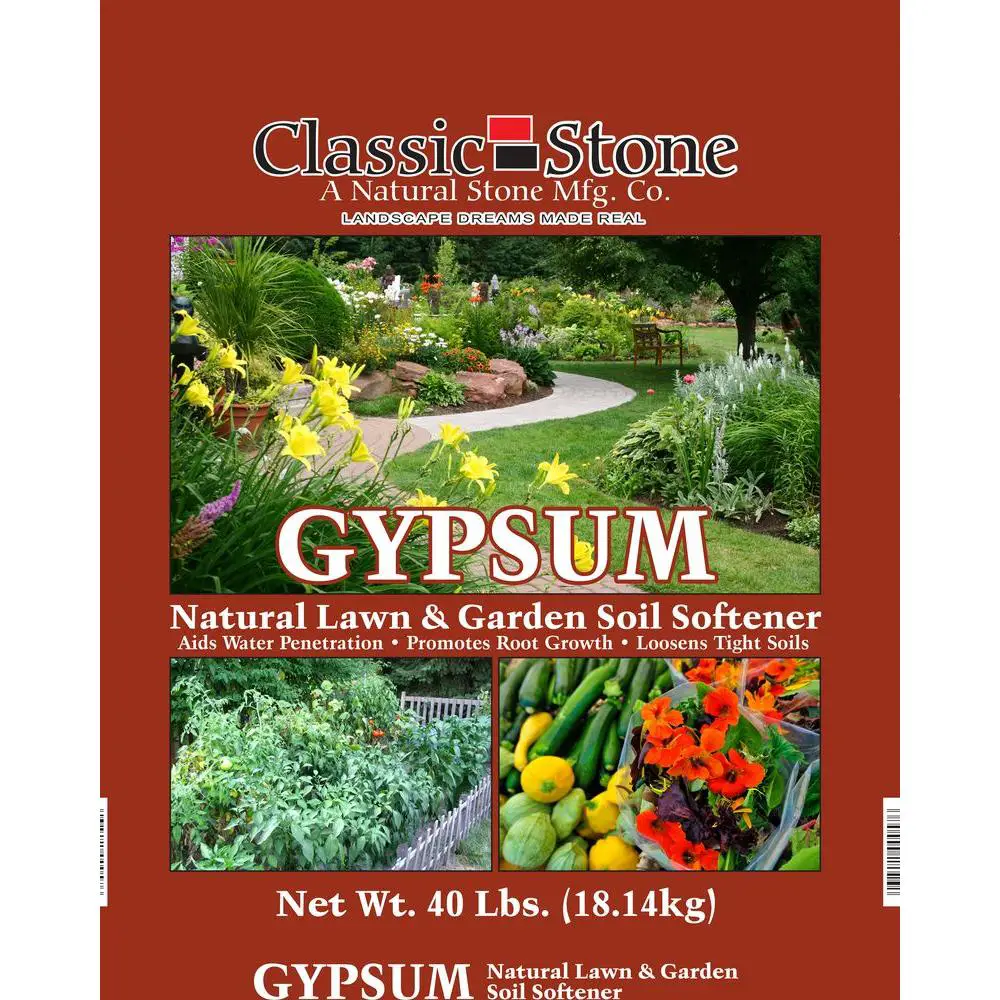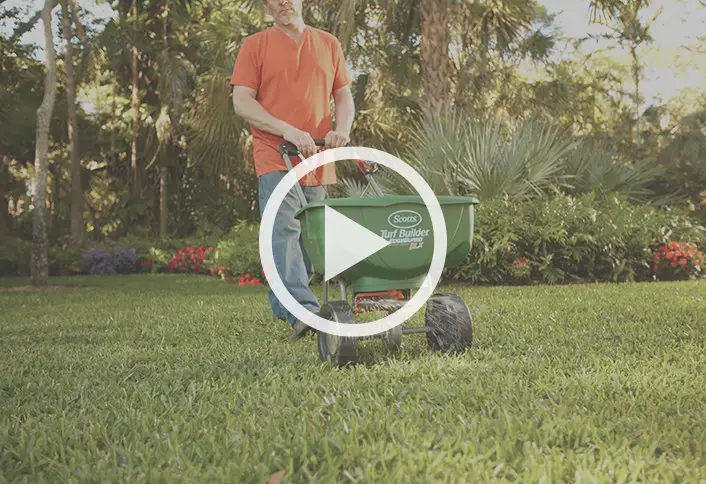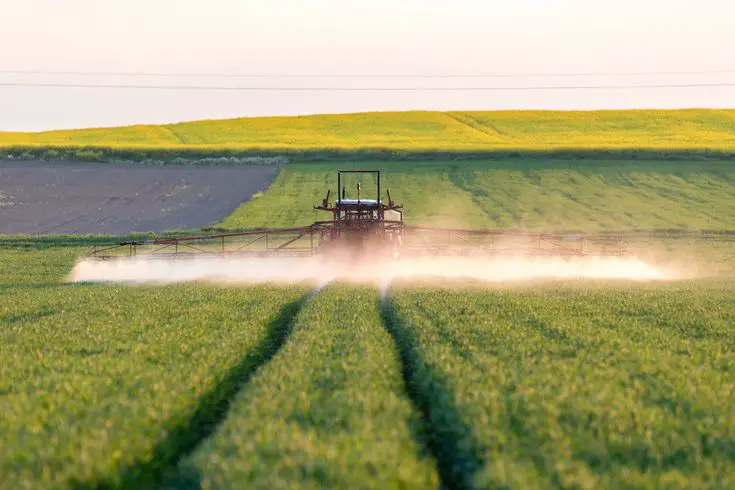Gypsum Improves Fruit Quality And Prevents Some Plant Diseases
Calcium is nearly always only marginally sufficient and often deficient in developing fruits . Good fruit quality requires an adequate amount of calcium. Calcium moves very slowly, if at all, from one plant part to another and fruits at the end of the transport system get too little. Calcium must be constantly available to the roots. In very high pH soils, calcium is not available enough therefore, gypsum helps. Gypsum is used for peanuts, which develop below ground, to keep them disease free. Gypsum helps prevent blossom-end root of watermelon and tomatoes and bitter pit in apples. Gypsum is preferred over lime for potatoes grown in acid soils so that scab may be controlled. Root rot of avocado trees caused by Phytophthora is partially corrected by gypsum and organics .
Gypsum Decreased Dust Erosion
Use of gypsum can decrease wind and water erosion of soil . Severe dust problems can be decreased, especially when combined with use of water-soluble polymers. Less pesticide and nutrient residues will escape for the surface of land to reach lakes and rivers when appropriated amendments are used to stabilize the soil. Gypsum has several environmental values.
Also Check: When To Start Watering Lawn In Colorado
Why Gypsum Might Not Be The Best Solution
Over-application of gypsum can strip essential nutrients from your soil, and this can harm plant growth. It can also strip out too much sodium from soils that are already low in salt.
You also need to apply gypsum regularly to ensure it has a continued benefit. It isn’t enough to do one treatment and think this will be a permanent solution. After a few months, the effects will begin to wear off and the soil composition will revert to its original state. Applying a treatment at least annually will be required.
Despite claims by some manufacturers, there isn’t any strong evidence to suggest that gypsum is a worthwhile addition in terms of fertility.
Don’t Miss: Too Much Oil In Mower
What Does Gypsum Do For Your Lawn
Before you decide to use gypsum in your grass lawn, its essential to first conduct a soil analysis to see if it is necessary to add gypsum to your lawn. Its also important to know the kind of soil you have in your yard.
For example, if you live in the coastal region, you might need to add gypsum to your soil to minimize soil salt levels. However, if you have sandy soil in your lawn, its advisable not to apply gypsum to prevent excess calcium accumulation.
Moreover, in areas where sodium levels are low, adding gypsum can deny the soil the much-needed salt.
Ok, why that in mind lets see what exactly does gypsum do for your lawn?
How Do You Soften Hard Clay Soil

Soften your hard soil by adding decomposed organic material, such as compost, which not only improves workability but increases fertility. Including gypsum, or calcium sulfate, in the mix will bind the organic matter to the soil particles and prevent the soil from crusting over or cracking once dry.
Recommended Reading: Perfect Match Herbicide
What Does Gypsum Do For Soil
Improving soil structure helps farmers with some common agricultural problems. Adding gypsum to the soil reduces erosion by increasing the ability of soil to soak up water after precipitation, thus reducing runoff. Gypsum application also improves soil aeration and water percolation through the soil profile.
So Where Does Lime Fit In
Lime is still a product we will use because of its benefits in increasing a soils pH and keeping lawns healthy. Where a soil test has been done or on a site where we know the ph is going to be too low we will use lime. Indications that the soil is acidic would be
- Moss growing in full sun areas
- The weed red sorrel is an indicator of low pH
- Subdivisions that were previously blueberry fields or are near them may have a low pH level.
The AAA Lawn Care lime/gypsum applications will reinvigorate your lawn with the lime working to increase pH, and the gypsum adding high levels of calcium and sulfur. The combination of both the lime and gypsum leaves your lawn filled with nutrients and improved soil structure. Request an estimate below to find out what a lime/gypsum lawn application will cost you.
Recommended Reading: How Much Peat Moss For Lawn
You May Like: How To Kill Wild Violet Weeds In Lawn
How Much Gypsum Do I Add To My Lawn
4.9/5gypsumlawns
Too much sodium in soil will damage good soil structure by displacing other elements needed by plants. Salt is probably most damaging on clay soils. Applying gypsum for lawns will dislodge the sodium which slowly restores the proper soil structure. It is an important part of improving soils affected by salt.
Similarly, can you put Gypsum on grass seed? Gypsum improves soil porosity, which is the soil’s ability to absorb nutrients. Gypsum will allow easier soil penetration for seedling grass and can be applied at a rate of up to 60 lbs. per 1,000 feet of lawn area. After the second or third mowing you can apply gypsum and it will work its way into the soil.
People also ask, how often can I put gypsum on my lawn?
Since Gypsum can be used on any soil type because it does not alter the soil pH level, you don’t have to balance your pH level before applying. Also, since Gypsum is not a fertilizer, it can be used before or after a fertilizer application, anytime of the season.
How much gypsum should I use?
To use gypsum as a soil amendment, spread it over soil at a rate of about 10 to 15 pounds per 100 square feet of soil surface using a garden spreader or by gloved hand, then till it into the top 6 to 8 inches of soil. Handle gypsum carefully and apply according to manufacturer recommendations.
Gypsum Enhances Your Soil And Delivers Extra Benefits To Your Garden
Improving soil structure and relieving compaction aren’t the only ways that gypsum benefits your lawn and garden. Gypsum adds calcium and sulfuressential plant nutrientsto your soil. While lime adds calcium and makes soil less acidic, gypsum adds calcium without affecting your soil pH.
Adding gypsum to vegetable gardens helps prevent calcium deficiency, a primary cause of blossom end rot disease. This common disease can undermine your harvest of garden favorites such as tomatoes, eggplants, peppers, and melons. Adding gypsum at planting time keeps calcium plentiful, so fruit can ripen without end rot. The calcium in gypsum helps your strawberry patch reach its juicy potential, too.
By taking steps to improve and maintain your heavy clay soil, you can enjoy all the benefits clay offers and reap the rewards of healthy soil and plants. Pennington is here to help you overcome lawn and garden challenges and grow the best lawn and garden possible, in heavy clay and every other soil type.
Always read product labels thoroughly and follow instructions.
Pennington with design is a registered trademark of Pennington Seed, Inc.
Fast Acting is a trademark of Encap, LLC.
Read Also: How To Use Peat Moss For Grass
How Does Gypsum Help In Plant And Soil Health
Here are some of the benefits of using gypsum for our garden:
1. It is a Good Source of Sulfur and Calcium.
Gypsum is a good source of calcium and sulfur which is essential for improved plant growth. As time passes, plants are having less amount of sulfur which is essential in plant nutrition and enhancing crop harvest. Even the soil is not giving enough of it, thus applying gypsum will boost the amount of sulfur in the soil to provide to the plants. Calcium also helps speed up root growth thus allowing more nutrients to be absorbed by the plants.
2. Improves the Structure of the Soil
The calcium in Gypsum improves flocculation or soil aggregation. Flocculation is vital to allow water and air movement and root growth in the soil.
3. Reduce Aluminum Toxicity
Gypsum helps treat aluminum toxicity which often goes together with soil acidity in subsoils. With this, it allows deeper rooting of plants that proves to be beneficial to the crops.
4. Enhances Water Access
Applying gypsum in the soil enhances the water permeation of the soil due to swelling clay and increased amounts of sodium, thus allowing water to have access and move in the soil making our crops go well. This also improves the chance of the crops to survive drought as it improves the structural properties of the soil that allows the positive soil-water relations to take place.
Read more about how to choose the Best Organic Weed and Feed Fertilizer for Your Garden
How Much Does A Gypsum Application Cost
Depending upon the reason for an application, the quantity of Gypsum can vary significantly. The amounts of Gypsum for lawn applications can range from 20 50 pounds per 1000 square feet, therefore changing the material cost significantly.
If a lawn application is needed, the minimum application cost is $90. However, if the application is selective, such as for rock salt damage, then the costs can vary.
Also Check: Aarons Pay Stub
When Should I Spread Gypsum To My Lawn
Improving soil structure helps farmers with some common agricultural problems. Adding gypsum to the soil reduces erosion by increasing the ability of soil to soak up water after precipitation, thus reducing runoff. Gypsum application also improves soil aeration and water percolation through the soil profile.
What Is Gypsum Used For Globally

Gypsum is the most commonly utilized sulfate mineral mined across the world. Amongst other things, it’s used in the building trade to make up drywall, plaster, and building blocks. It’s even used to produce writing chalk, as a food additive, and, in its fine-grained alabaster variety, it’s made into ornamental sculptures.
Another common usage for gypsum is for soil conditioning and fertilizing on an industrial or large-scale agricultural level.
Don’t Miss: How To Get Rid Of Corn Speedwell In Lawn
Gypsum Decreased Ph Of Sodic Soils
Gypsum immediately decreases the pH of sodic soils or near sodic soils from values often over 9 but usually over 8 to values of from 7.5 to 7.8. These values are in the range of acceptability for growth of most crop plants. Probably more than one mechanism is involved. According to Lindsay , Ca++ reacts with bicarbonate to precipitate CaCO_3 and release protons which lessens the hydrolysis of clay to form hydroxides. These reactions can decrease the incidence of lime-and bicarbonate-induced iron deficiency.
Also Check: Overfilled Oil In Lawn Mower
How Gypsum Improves Drainage
Question from Barbara:Can you tell me whether adding gypsum will truly help break up and/or improve clay soil in the home garden? The information I find on line is conflicting and confusing. So glad youre there to help us.
Answer from Pat:Gypsum is a relatively inexpensive mineral mined from the earth and sold in bags. Gypsum is indeed an excellent way to combat problems with bad drainage in clay soils in areas where soils are alkaline and where the cause of bad drainage is the alkalinity of the clay. In other words, gypsum is an excellent additive for clay soils throughout the west and southwest or wherever clay soils are alkaline. If the lack of drainage is cause by physical factors such as compaction, gypsum wont help that problem, but if the soil is not draining because of its alkalinity then gypsum will help it to drain.
What compaction means is illustrated by this example: If you have heavy clay soil and you have a horse trail on top of it, applying gypsum on top of the trail probably wont help the puddles to drain away from the horse trail because the clay has been compacted by the weight of the horses and it has been puddled by the horses hoofs. In this case, a better solution would be to slope the trail slightly to drain off the water and then cover it with with a thick layer of mulch. No gardener should walk on his garden soil when it is wet, but particularly if it is clay soil since this increases compaction.
No related posts.
Don’t Miss: How To Kill Creeping Charlie In Lawn
How Much Gypsum Do I Apply
Set a lawn spreader or hand-held garden spreader to 40 pounds per 1000 square feet for existing lawns or gardens, or 20 to 30 pounds per 1000 square feet for unplanted soil. Add granulated gypsum to the spreader hopper until the gypsum reaches the fill line.
Similarly, Will gypsum kill plants?
Garden Gypsum Information. As a rule, using gypsum for garden tilth will probably not harm your plants, but it simply is not necessary. Studies have shown that soils with at least 10 percent organic matter dont benefit from the addition of gypsum.
Also, Is Gypsum harmful to humans? Gypsum products are not classified as dangerous according to EU CLP Regulations. There are no long term adverse medical effects from ingestion of gypsum. If ingested, wash out the mouth and drink plenty of water. Plaster powders/dust potentially may irritate eyes or sensitive skin or irritate the respiratory system.
26 Related Questions and Answers Found ?
Reasons To Add Gypsum To Your Gardens & Lawns
Gypsum is a sulfur mineral that has been mined in Virginia since the 1700s. It has many uses, from drywall and glassware to casts. I use it, however, for breaking up clay soil. There are many aspects to gypsum that make it a superior soil additive in Virginia, lets go over the list.
1. Gypsum breaks up compacted soil.
Roots need maximum surface area contact with their nutrient-dense soil in order to grow fast, large and produce many fruits. Gypsum helps by breaking clay down into fewer, larger particles. This allows for the smaller particles that saturate the root surface to be your fertilized soil, not toxic clay.
2. Add gypsum to your soil for years of no-till maintenance.
In my area, clay compaction and water erosion are huge issues that tend to make each other worse. Gypsum is an easy fix for this problem and sticks around for years, so maintenance is not too often. When water floods and recedes, it can build up toxins in the soil that you would need to remove somehow. Instead of replacing the soil, just add gypsum, to soak up the re-used water and keep toxins away from your roots. Care must be taken, however, because the surface layer of clay can be a problem area for sodium retention. Make sure to till your gypsum in deep, so the roots do not end up laying in that surface layer of clay and salts.
3. Gypsum prevents the ground from crusting over, helping your seeds bloom.
4. Gypsum provides for reduced nitrogen loss through evaporation in the air.
Recommended Reading: Where Are Honda Mowers Made
How Much Gypsum Can You Add To Soil
Most farmers and gardeners resort to using gypsum to salvage Alkali soils. Aside from it, home gardeners also faced hardpan types of soil or clay soil which is not suitable for plant growth. Gypsum for soil remedies this problem by breaking down compacted soil to allow good drainage and nutrient absorption, essential in plant growth.
However, applying too much gypsum in the soil may also mean eliminating essential nutrients from the soils such as aluminum, iron, and manganese. Removal of these nutrients may lead to poor plant growth. Therefore, it is vital to exactly know how much gypsum to add to the soil.
What Does Adding Gypsum To Soil Do
Gypsum is calcium sulfate, a naturally occurring mineral. It has been touted as beneficial for breaking up compact soil, especially clay soil. It is useful in changing the soil structure of excessively heavy soils which have been impacted by heavy traffic, flooding, overcropping, or simply overly weatherized.
You May Like: How To Kill Wild Violet Weeds In Lawn
Is It Necessary To Apply Gypsum
Before you choose to apply gypsum in your garden, a soil analysis must be done to determine if it is really necessary to apply gypsum to your soil. Also, you must consider the type of soil you have in your garden. For instance, those living in coastal areas might need to apply gypsum to reduce the salt levels of their soil while those who have sandy soils must not do so to avoid excess calcium accumulation. Furthermore, in places where there are already low levels of sodium, applying gypsum may also deprive the soil of salt.
How Often Should You Apply Gypsum

Now you know the pros and cons of powdered vs liquid gypsum you may be wondering how often you should use it.
Applying gypsum once per year is more than enough to see tangible positive results. Although some gardeners will tell you that you can use gypsum several times per year, I strongly advise against this. This advice is often given to lawn owners who will not suffer as much from multiple gypsum applications as cultivators of plants and vegetables.
If you are cultivating any types of crops, from vegetables to flowering garden plants, using too much gypsum can have a very negative effect on their growth.
Although gypsum will have no effect at all on the pH value of the soil adding too much of it can result in the elimination of much needed nutrients such as iron, manganese and aluminum which plants need for healthy growth.
Applying gypsum once per year is more than enough. If you are overly concerned about compacted soil aerate the ground!
To ensure even a once-per-year application has no negative effect on growing plants, I use a gypsum based soil repairer mix that has the type of nutrients added to it that gypsum naturally strips away.
Don’t Miss: When To Fertilize Lawn In Iowa
